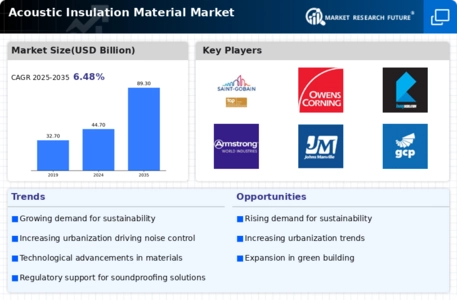Growing Urbanization
The rapid pace of urbanization globally drives the demand for acoustic insulation materials. As urban populations swell, the need for residential and commercial buildings increases, leading to heightened noise levels. The Global Acoustic Insulation Material Market Industry is responding to this trend by providing solutions that enhance soundproofing in densely populated areas. For instance, cities like Tokyo and New York are experiencing significant noise pollution, prompting developers to incorporate advanced acoustic insulation materials in their projects. This trend is expected to contribute to the market's growth, with projections indicating a market value of 44.7 USD Billion in 2024.
Technological Advancements
Technological advancements in material science are significantly impacting the Global Acoustic Insulation Material Market Industry. Innovations such as the development of lightweight, high-performance acoustic panels and sound-absorbing materials are enhancing the effectiveness of soundproofing solutions. For instance, the introduction of eco-friendly materials that provide superior acoustic performance is gaining traction among manufacturers. These advancements not only improve sound insulation but also cater to the growing demand for sustainable building practices. As the market evolves, it is anticipated that the value will reach 89.3 USD Billion by 2035, driven by continuous innovation and consumer preferences for high-quality acoustic solutions.
Diverse Applications Across Industries
The versatility of acoustic insulation materials across various industries is a key driver for the Global Acoustic Insulation Material Market Industry. These materials find applications in sectors such as construction, automotive, and manufacturing, where sound control is essential. For example, in the automotive industry, manufacturers are utilizing acoustic insulation to enhance passenger comfort by reducing engine noise. Similarly, in construction, these materials are critical for ensuring compliance with noise regulations. The diverse applications not only broaden the market's reach but also stimulate innovation, contributing to a robust growth trajectory.
Increased Awareness of Noise Pollution
The rising awareness of noise pollution and its adverse effects on health and well-being is propelling the Global Acoustic Insulation Material Market Industry. Individuals and organizations are becoming more cognizant of the importance of sound insulation in creating conducive environments for work and relaxation. This awareness is particularly evident in urban areas where noise levels are a concern. Consequently, there is a growing demand for effective acoustic insulation solutions in both residential and commercial sectors. This trend is likely to bolster market growth, as consumers increasingly seek products that mitigate noise pollution and enhance quality of life.
Regulatory Standards and Building Codes
Stringent regulatory standards and building codes aimed at noise reduction are pivotal in shaping the Global Acoustic Insulation Material Market Industry. Governments worldwide are increasingly mandating the use of sound insulation materials in construction to enhance living conditions and promote public health. For example, the European Union has implemented directives that require sound insulation in residential buildings, influencing market dynamics. Compliance with these regulations not only ensures safety but also drives innovation in acoustic materials. As a result, the market is likely to expand, with a projected CAGR of 6.48% from 2025 to 2035, reflecting the growing emphasis on soundproofing.



















Leave a Comment